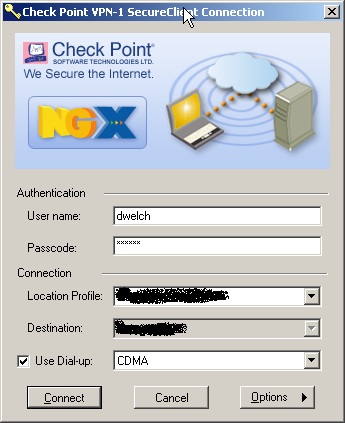
When I was at the car dealer yesterday giving my car some service love, I hung out at the dealership while the repair was taking place. My dealer is pretty good--they give you a coupon (or two) for a free latte while you wait for your car to be serviced. They offer WiFi throughout their waiting area. They also have a "lounge" where you can either use one of the computers they have or use your own.
Despite the dealer having WiFi, I didn't use it. Why? Their system requires reauthenticating every two hours, which gets old when I know I am going to be there for at least twice that long. Instead, I decided to use my Sprint EVDO dongle.
Unfortunately, I spent a long time fighting with the Sprint Connection Manager software (version 1.10.0023.0) instead of working. When I tried to use it to connect, then started up my VPN to connect to the office, my EVDO connection would unceremoniously disconnect. I don't remember my Verizon card ever doing this.
I eventually figured out how to get this combination working. The hint is in the graphic here. Sprint's software--and presumably Verizon's software--are simply front ends for the standard Windows dial-up networking. Sprint's software also has this NDIS mode in it--make sure it's set to RAS before you do this trick.
In Check Point Secure Client (which us old-timers still call SecuRemote), I told it to use a Dial-up connection, which shows up in the Connection window. In my case, I ticked the Use Dial-up option and used the connection called CDMA. There was another one called 3G Connection that I didn't try. After this, Secure Client properly brought up the EVDO connection and started my VPN. The connection didn't drop once and worked reliably for the rest of the time I was at the dealer.
I left the Sprint Connection Manager software running, but I don't believe it was necessary. It continued to show me signal strength and the like, but I did not see any details about how much data I was sending and receiving. That's ok, just as long as my EVDO worked.